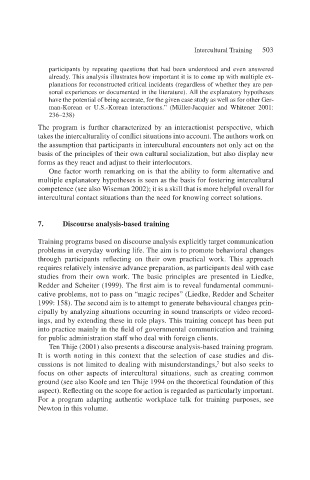Page 525 - Handbooks of Applied Linguistics Communication Competence Language and Communication Problems Practical Solutions
P. 525
Intercultural Training 503
participants by repeating questions that had been understood and even answered
already. This analysis illustrates how important it is to come up with multiple ex-
planations for reconstructed critical incidents (regardless of whether they are per-
sonal experiences or documented in the literature). All the explanatory hypotheses
have the potential of being accurate, for the given case study as well as for other Ger-
man-Korean or U.S.-Korean interactions.” (Müller-Jacquier and Whitener 2001:
236–238)
The program is further characterized by an interactionist perspective, which
takes the interculturality of conflict situations into account. The authors work on
the assumption that participants in intercultural encounters not only act on the
basis of the principles of their own cultural socialization, but also display new
forms as they react and adjust to their interlocutors.
One factor worth remarking on is that the ability to form alternative and
multiple explanatory hypotheses is seen as the basis for fostering intercultural
competence (see also Wiseman 2002); it is a skill that is more helpful overall for
intercultural contact situations than the need for knowing correct solutions.
7. Discourse analysis-based training
Training programs based on discourse analysis explicitly target communication
problems in everyday working life. The aim is to promote behavioral changes
through participants reflecting on their own practical work. This approach
requires relatively intensive advance preparation, as participants deal with case
studies from their own work. The basic principles are presented in Liedke,
Redder and Scheiter (1999). The first aim is to reveal fundamental communi-
cative problems, not to pass on “magic recipes” (Liedke, Redder and Scheiter
1999: 158). The second aim is to attempt to generate behavioural changes prin-
cipally by analyzing situations occurring in sound transcripts or video record-
ings, and by extending these in role plays. This training concept has been put
into practice mainly in the field of governmental communication and training
for public administration staff who deal with foreign clients.
Ten Thije (2001) also presents a discourse analysis-based training program.
It is worth noting in this context that the selection of case studies and dis-
7
cussions is not limited to dealing with misunderstandings, but also seeks to
focus on other aspects of intercultural situations, such as creating common
ground (see also Koole and ten Thije 1994 on the theoretical foundation of this
aspect). Reflecting on the scope for action is regarded as particularly important.
For a program adapting authentic workplace talk for training purposes, see
Newton in this volume.

